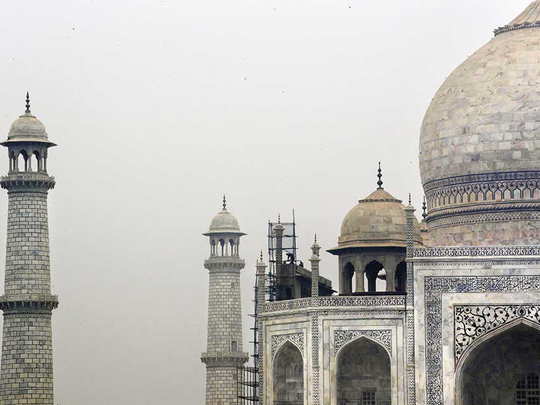
AGRA: Authorities in India are trying to figure out how workers will scale the Taj Mahal’s majestic but delicate dome as they complete the first thorough cleaning of the World Heritage site since it was built 369 years ago.
Work on the mausoleum’s minarets and walls is almost finished, after workers began the makeover in mid-2015.
They’ve been using a natural mud paste to remove yellow discolouration and return the marble to its original brilliant white. Called fuller’s earth, it’s the same clay that some people smother on their skin as a beauty treatment.
- Bhuvan Vikrama | Superintending archaeologist, ASI
But the metal scaffolding used so far is too heavy and rigid for the dome, said Bhuvan Vikrama, the superintending archaeologist from the Archaeological Survey of India. He said they’re considering other options, including designing and constructing special bamboo scaffolding.
He said there’s a precedent, after bamboo scaffolding was used on the dome in the early 1940s when some conservation work was carried out.
Vikrama said rain was enough to clean most of the Taj Mahal in the past but air pollution over the last 25 years had taken its toll.
“It became visibly clear it was all yellow,” he said. “It even started becoming black in the shaded areas not washed by rains.”
He said work on the dome would likely take 10 months, starting next year and finishing in 2019. The makeover was costing a total of about $500,000.
The work has prompted Fodor’s Travel guide to include the Taj Mahal on its list of places not to visit next year.
“Unless your dream Taj Mahal visit involves being photographed standing in front of a mud-caked and be-scaffolded dome, maybe give it until 2019 at the earliest,” the guide recommends.
Vikrama disagrees, saying photographs from the 1940s with scaffolding on the dome are interesting and historically important.
“If the tourism even fluctuates, we should not bother about that,” he said. “Tourists should also appreciate they are witnessing the work going on, the right kind of efforts for the preservation of monuments.”
The Taj Mahal typically attracts between seven and eight million visitors a year. Built by Mughal Emperor Shah Jahan in memory of his wife Mumtaz Mahal, people are attracted as much by the love story as the spectacular architecture.
“It’s the most beautiful thing I’ve ever seen,” said Kent Scheibel, a tourist from Los Angeles who was visiting the site this week. “It’s a living, breathing thing that emanates the absolute beauty of the human spirit.”












